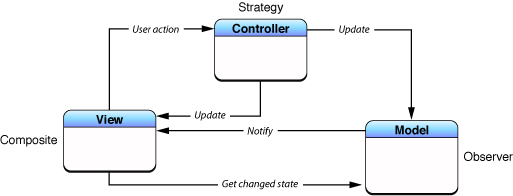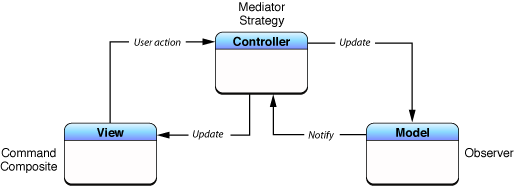Choosing an architectural pattern
This section will explore a foundamental aspect of mobile application development: the architectural pattern.
When developping a mobile applications, usually the target platform implicitely or explicitely suggests an architecture.
State of the art in iOS
In the iOS world, Apple encourages the usage of the Model-View-Controller (MVC) architectural pattern. Quoting the "Start Developing iOS Apps Today" Apple's documentation:
MVC assigns the objects in an app to one of three roles: model, view, or controller. In this pattern, models keep track of your app’s data, views display your user interface and make up the content of an app, and controllers manage your views. By responding to user actions and populating views with content from the data model, controllers serve as a gateway for communication between the model and views.

In its original abstraction, in MVC:
- the user manipulates a view and, as a result, an event is generated
- a controller receives the event and manage apply an appliction-specific strategy
- this strategy can consist in requesting a model object to update its state or in requesting a view object to change its appearance.
- the model object notifies all objects who have registered as observers when its state changes; if the observer is a view object, it may update its appearance accordingly.

However, in an attempt to enhance code reusability, Apple suggests developers to adopt a modified version of MVC, in which there's a strong isolation from models and views, and in which controllers act an intermediary between one or more of an application’s view objects and one or more of its model objects.
Even if views and view controllers are technically distinct components and Apple suggests to keep these decoupled, they are almost always paired. There are a lot reason that cause this trend of strictly coupling a view and its controller:
- the framework provides a big set of components in which a controller already has and manages a view (
UIViewController,UITableViewController,UICollectionViewController,UISplitViewController,TabBarController, ...) - the UIViewController class usually contains a lot of UI-related code
- storyboards, that enable developers or designers to define GUIs, reason in term of view controllers and "segue" between view controllers
With this said, it is reasonable to modify the previous model with an update in which the view and the view controller are paired togheter.

The iOS community, during the years, has adopted (also unconsciously) this architectural pattern to design applications. This has often lead to what is called the "Massive View Controller" anti-pattern. The term "Massive" is used to denote the use and abuse of the view controller entity to host most of the application logic, grouping functionalities that don't stricly relate to the controller entity.
State of the art in Android
Android's documentation is less explicit about the architectural pattern that developers should use.
At first sight, the overall architecture looks similar at iOS's architecture, with the notion of Activity that is similar to UIViewController and the notion of View that is similar to UIView.
But, more in depth, things are far more complicated. Thus, the main flaw comes from the assumption that there should be only one running Activity at a time, and that this Activity should be tied down to a single main view.
To overcome this limitation, Android introduced the Fragment class. This new abstraction allows an activity to show and manage a certain number of fragments, but still has some limitations like, for example, the possibility of manage stack of fragments.
From this point of view, the iOS platform offers a clearer abstractions, with the notion of viewcontrollers, views and viewcontroller containers, that allow the developer to express multi-level view hierarchy in a cleaner way.
Many developers suggest that what Android is offering is a broken abstraction.
Knowing the limitations of the abstractions that the platform offers, the most popular architectural pattern for Android is a variant of MVC (similar to Apple's variant), in which the Activity (and related fragments) is both a the view and the controller.
Google encourages developers to split each view in a fragment, and then each fragment should interact with its parent activity, also to coordinate his actions and commands with other fragments.
Toward a common architecture: MVVM
On both the platforms, the MVC architectural pattern and its variations doesn't seem to be a perfect fit.
In this section and in the following ones a new architectural pattern will be proposed to better model mobile applications: the Model-View-ViewModel pattern.
The reason of the introduction of MVVM in this thesis is that this pattern is an application pattern that isolates the user interface from the underlying business logic, and, as introduced in the previous section, one of the biggest issue of the usage of the MVC pattern is the fact that in both Android and iOS there's not a clear distinction between the view and the controller entities.
The MVVM pattern consists of the following parts:
- the Model, which provides a view-independent representation of business entities;
- the View, which is the user interface, displaying information to the user and firing events in response to user interactions;
- the ViewModel, which is the bridge between the view and the model. Each View has at least a corresponding ViewModel. The ViewModel retrieves data from the Model and manipulates it into the format required by the View, wrapping the presentation logic. It notifies the View if the underlying data in the model is changed, and it updates the data in the Model in response to UI events from the View.

Looking at the diagram, it's clear that the view-model:
- sits between the model and the view, wrapping all the presentation logic
- receives the events and commands from the view
- updates the view once the model has been updated
The main reason to use MVVM is the it reduces the complexity of one’s viewcontrollers or activities and makes one’s presentation logic easier to test.
RP frameworks are a good fit in MVVM, since they allow to bind the views with their associated view-models, allowing the proper synchronization to reflect the changes in both directions.